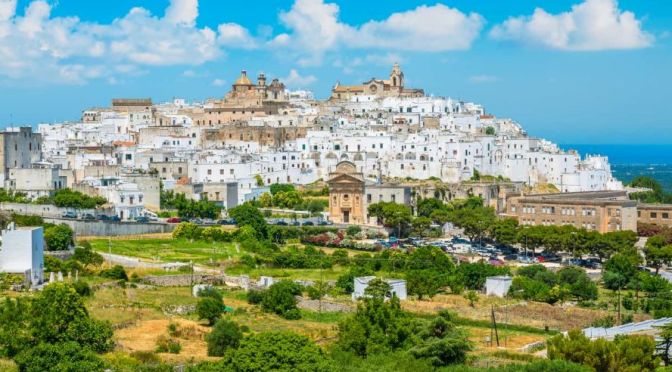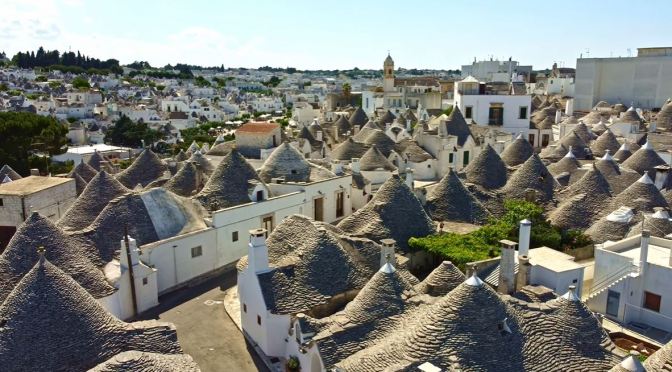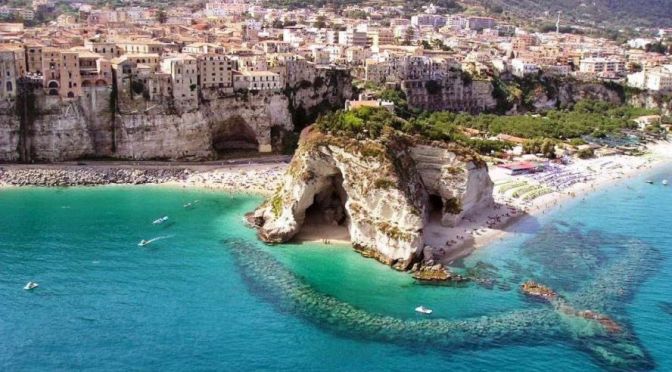Giovinazzo is a town and former bishopric within the Metropolitan City of Bari, Apulia region, southeastern Italy. It was a small fortified centre of the Romans, who called it Natolium, maybe built on the ruins of the Peucete Netium which was destroyed during the Punic Wars. The main sights are: the Co-cathedral, dedicated to Santa Maria Assunta (Mary’s Assumption), built in the Norman period 1150–1180, in characteristic Apulian Romanesque style featuring Eastern and Western elements and the Ducal Palace. In the neighbourhood is Castel del Monte, one of the most famous castles in southern Italy.
Tag Archives: Southeastern Italy
Walking Tours: Vieste In Puglia, Italy (4K Video)
Vieste is a coastal town in Gargano National Park, in southeast Italy. It’s known for its beaches, like Scialara, home to the imposing Pizzomunno limestone monolith, and the broad Spiaggia di San Lorenzo. Marine fossils and rare shells are on display at the Museum of Malacology. Nearby are the Castello Svevo, a medieval fortress, and the 11th-century Vieste Cathedral, with its baroque bell tower and painted ceiling.
Walking Tour: Terracina – Southeastern Italy (4K)
Terracina is an Italian city and comune of the province of Latina, located on the coast 56 km southeast of Rome on the Via Appia. The site has been continuously occupied since antiquity.
Video timeline: 0:00 – [Drone intro] 3:00 – [Walking tour begins / Roman Gate] 4:00 – [Via Villa Franca] 10:45 – [Church of the souls of Purgatory☀️] 12:30 – […walking continues…] 16:30 – [Corso Garibaldi] 23:00 – [Church of St.John☀️] 23:40 – [Brief History☀️] 30:00 – [Panorama on the coast] 31:00 – […walking continues…] 32:30 – [Brief history of the walls☀️] 34:00 – […walking continues…] 35:34 – [“New Gate”] 38:50 – [Roman “Capitolium”☀️] 41:00 – [Traces of the structure of an ancient Roman Temple – now the Cathedral of Terracina] 43:00 – [Via Garibaldi and narrow alleys nearby] 50:00 – [Piazza Cancelli and “Patrician Houses”☀️] 53:00 – [Piazza Tasso / Braschi Palace 18th century] 58:45 – [Roman amphitheatre☀️] 1:04:30 – [Roman arch with 4 faces] 1:06:30 – [Emilian Forum☀️] 1:09:29 – [Cathedral of Terracina – *tour inside*☀️] 1:11:30 – [Procession in front of the Church] 1:13:30 – [Church refectory and roman ruins] 1:16:11 – [Town Hall and Civic Museum of Terracina] 1:18:00 – [Via Annunziata] 1:19:30 – [St.Domitilla Square] 1:22:00 – [Climbing up…] 1:23:00 – [Tower of the Aqueduct] 1:24:00 – […walking continues…] 1:26:30 – [Roman Amphitheatre]
Walking Tour: Monopoli – Southeastern Italy (4K)
Monopoli is a town on the Adriatic Sea, in southern Italy. It’s known for the Baroque Monopoli Cathedral, featuring a tall bell tower. In its crypt is an archaeological museum with sculptures and ancient tombs. On a promontory to the north, the 16th-century Castle of Carlo V has a huge stone portal. Nearby is the frescoed Palmieri Palace, built by a wealthy local family in the late 1700s. ―
Boat Tours: Sea Caves Of Vieste, Puglia, Italy (4K)
The erosion of the Gargano coast cut through many karst cave systems, which are now sea caves. The caves are eroded by the mechanical forces of the waves, the result are sea caves like any other sea cave on earth, except for some remaining stalactites on the ceiling probably.
Timeline: 0:00 Vieste Lighthouse 0:15 Vieste Old Town 1:01 Arco di San Felice 1:52 Testa del Gargano 2:33 Grotta Sfondata 3:55 Grotta dei Due Occhi 4:44 Grotta dei Pomodori 6:25 More views of the rocky coast 8:37 Grotta delle Due Stanze 10:45 Grotta della Tavolozza
Vieste is a coastal town in Gargano National Park, in southeast Italy. It’s known for its beaches, like Scialara, home to the imposing Pizzomunno limestone monolith, and the broad Spiaggia di San Lorenzo. Marine fossils and rare shells are on display at the Museum of Malacology. Nearby are the Castello Svevo, a medieval fortress, and the 11th-century Vieste Cathedral, with its baroque bell tower and painted ceiling.
Village Walks: Cisternino In Southeastern Italy (4K)
Cisternino is a comune in the province of Brindisi in Apulia, on the coast of south-eastern Italy, approximately 50 kilometres north-west of the city of Brindisi. Its main economic activities are tourism, the growing of olives and grapes, and dairy farming.
Video timeline: 0:00 – [Drone intro] 2:00 – [Walking tour begins / Corso Umberto I] 3:40 – [Brief history of the town☀️] 6:45 – [Belvedere of Piazza Marconi] 7:40 – [Via Manzoni] 10:30 – [Villa Garibaldi park] 11:55 – [Torre Grande (“Big Tower”)☀️] 12:50 – [St.Nicolas Church☀️] 19:12 – […walking in the old town…] 20:40 – [Piazza Vittorio Emanuele] 23:00 – [Church of St.Lucia☀️] 25:15 – […walking continues…] 42:00 – [Porta Piccola (“small gate”)] 43:40 – […walking continues…] 1:00:23 – [Piazza Pellegrino Rossi] 1:04:00 – […walking continues…] 1:06:30 – [Southern Gate] 1:08:00 – [Via Manzoni]
Village Walks: Ostuni – Southeastern Italy (4K)
Ostuni is a city in Italy’s Apulia region that’s known for its whitewashed old town. Ostuni Cathedral combines Gothic, Romanesque and Byzantine elements, while the arched Porta San Demetrio is one of 2 remaining medieval gates. The Civic Museum and Archaeological Park houses Ostuni 1, the skeleton of a woman from Paleolithic times. Northwest of town is the Santuario di Sant’Oronzo complex, with a triumphal arch.
Walks: Alberobello In Southeastern italy (4K)
Alberobello is a town in Italy’s Apulia region. It’s known for its trulli, whitewashed stone huts with conical roofs. The hilltop Rione Monti district has hundreds of them. The 18th-century Trullo Sovrano is a 2-level trulli. Furniture and tools at the Museo del Territorio Casa Pezzolla re-create life in the trulli as it was centuries ago. Southwest of town is the Casa Rossa, a WWII internment camp.
Seaside Walks: Tropea – Southeastern Italy (4K)
Tropea is a small town on the east coast of Calabria, in southern Italy. It’s known for its clifftop historic center, beaches and prized red onions. Built on a former Byzantine cemetery, the 12th-century cathedral has marble sarcophagi and a painting of the Madonna of Romania, the town’s protector. Nearby is a viewpoint over the hills. The centuries-old Santa Maria dell’Isola Church is on a rock overlooking the sea.









